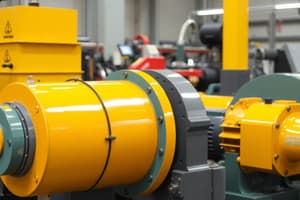Podcast
Questions and Answers
What is the fundamental principle of operation for DC machines?
What is the fundamental principle of operation for DC machines?
Electromagnetic induction
Explain the role of the commutator in a DC motor.
Explain the role of the commutator in a DC motor.
The commutator ensures continuous and controlled rotation by reversing the direction of current flowing through the windings at specific points.
What are the four basic parts of a DC motor?
What are the four basic parts of a DC motor?
Stator, commutator, brushes, rotor (armature)
What is the primary function of the stator in a DC motor?
What is the primary function of the stator in a DC motor?
How do DC generators primarily transform energy?
How do DC generators primarily transform energy?
Why are brushes important in a DC machine?
Why are brushes important in a DC machine?
What is the main difference between brushed DC motors and brushless DC motors?
What is the main difference between brushed DC motors and brushless DC motors?
Describe the construction of the rotor in a DC machine.
Describe the construction of the rotor in a DC machine.
What is the function of the commutator in a DC machine?
What is the function of the commutator in a DC machine?
Provide two examples of automotive systems where DC machines are commonly used.
Provide two examples of automotive systems where DC machines are commonly used.
Why is regular maintenance necessary for DC machines?
Why is regular maintenance necessary for DC machines?
How do DC machines contribute to efficient operations in industrial settings?
How do DC machines contribute to efficient operations in industrial settings?
Flashcards are hidden until you start studying
Study Notes
DC Machines
Direct current (DC) machines are integral to numerous technological applications due to their versatility and efficiency. They consist of two primary categories: DC motors and DC generators. DC motors convert DC power into mechanical power, while DC generators primarily transform mechanical power into DC electrical power. In this article, we delve into the principles of operation, types, construction, applications, and maintenance of DC machines, providing a comprehensive understanding of these electromechanical marvels.
Principles of Operation
DC machines operate based on the fundamental principle of electromagnetic induction, where electric current generates magnetic fields that interact to create torque and mechanical rotation. This interaction occurs between the rotor (armature) and stator, converting electrical energy into mechanical motion.
DC motors consist of four basic parts: the stator, commutator, brushes, and rotor (armature). The stator creates a magnetic field from permanent magnets or electromagnets, setting the stage for interaction with the rotor. The commutator, located on the rotor, ensures continuous and controlled rotation by reversing the direction of current flowing through the windings at specific points throughout its path. Brushes function as sliding contacts, connecting the external power source to the rotor windings.
Types of DC Machines
There are several variations of DC machines, including brushed DC motors and brushless DC motors (BLDC). Brushed DC motors have a rotor with windings and a stator with permanent magnets, while BLDC motors feature a rotor with permanent magnets and a stator with windings. BLDC motors use sensors to determine the position of the rotor, allowing for electronic commutation without physical brushes.
Construction of DC Machines
DC machines have a simple construction that allows for efficient conversion of electrical to mechanical energy. The stator forms the stationary part of the machine, housing the magnets or electromagnetic coils. The rotor (armature) consists of windings that generate magnetic fields when subjected to electrical current. The commutator, made up of conductive segments, is attached to the rotor shaft and facilitates the switching of current flow between windings as the rotor turns. Brushes connect the rotor windings to an external DC power source, ensuring a continuous supply of electric current.
Applications of DC Machines
DC machines are widely used in various industries and applications due to their high starting torque and variable speed control capabilities. They find significant use in automotive systems like starter motors, windshield wipers, and window regulators. In industrial settings, they contribute to efficient operations in manufacturing processes involving conveyors, elevators, cranes, and drilling machines. Healthcare devices such as insulin pumps and wheelchairs also rely on DC motors for precise speed control and simplicity of design.
Maintenance of DC Machines
While DC machines have minimal moving parts, regular maintenance is necessary to ensure longevity and optimal performance. Brushes may need periodic replacement due to wear, while commutators require cleaning to maintain conductivity. Proper lubrication of bearings and maintaining clean operating conditions are essential components of routine preventative maintenance programs.
In conclusion, DC machines play a vital role in transforming electrical energy into mechanical motion, underpinning numerous technological advancements across diverse sectors. Understanding their principles of operation, types, construction, applications, and maintenance provides valuable insights into these electromechanical marvels' functionality and significance in our modern world.
Studying That Suits You
Use AI to generate personalized quizzes and flashcards to suit your learning preferences.




